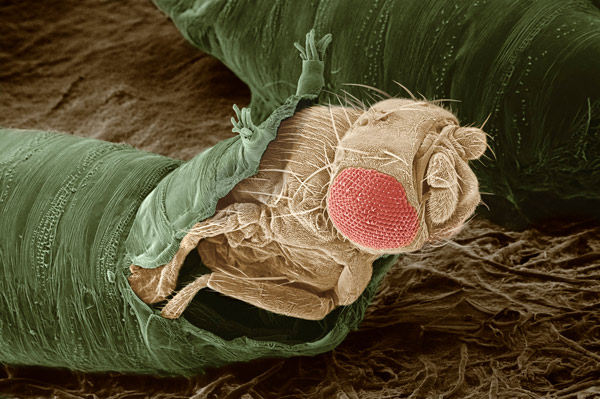Oct. 25, 2023 Research Highlight Biology
Signaling molecule from cancer cells induces metabolic changes to fruit fly larvae
The connection between local tumors and body-wide changes to metabolism has been revealed in fruit-fly larvae
Local, tumor-induced stress in fruit fly larvae releases a signaling molecule that reprograms the metabolism of the animals, an all-RIKEN team has discovered1. If the same thing happens in humans, it could lead to new ways of treating cancer-induced complications, which are often fatal.
How cancer kills people is often mysterious. In some cases, it causes a vital organ to misfunction. But more frequently, cancer kills by causing changes that affect the body as a whole.
A case in point is cancer-induced cachexia, a wasting syndrome that causes muscle and fat loss. It contributes to the emaciated appearance of many cancer patients. Cachexia is estimated to occur in 80% of people with advanced cancer and to directly cause 30% of all cancer deaths.
But how cancer gives rise to these body-wide complications has been unclear. “There are still a lot of things that we don’t understand about cancer cachexia,” says Morihiro Okada of the RIKEN Center for Biosystems Dynamics Research. “And there are very limited options for treating it.”
Now, Okada, Sa Kan Yoo and co-workers have discovered that cancer-induced stress in fruit fly larvae produces a protein known as Netrin, which reprograms the metabolism of the larvae.

Figure 1: Scanning electron micrograph of a fruit fly emerging from a puparium. RIKEN researchers have discovered that, in larvae with cancer cells, the protein Netrin reprograms the metabolism of the organism. © DR JEREMY BURGESS/SCIENCE PHOTO LIBRARY
This is the first time that Netrin, which plays a role in guiding cell and nerve axon migration during development, has been implicated in spreading the effects of a local cancer to the metabolism of the organism.
The team engineered fruit flies with a mutant gene that causes tissue that normally develops into eyes in larvae to become tumors. Even though the cancer cells did not multiply excessively, about 80% of the larvae with the mutation died within days.
The researchers conjectured that factors secreted by the cancer cells were negatively impacting the entire body. They identified 20 factors, including Netrin, whose expression was upregulated in cancer cells. Follow-up analysis revealed that inhibiting the expression of Netrin markedly increased the survival rate of larvae, even though it didn’t affect the cancer cells. “Almost all the larvae survived after knocking down Netrin,” says Okada.
Human cancer patients often have elevated levels of Netrin, suggesting that the same mechanism may occur in people. “Recently a lot of researchers have been focusing on Netrin in tumor cells because it’s highly expressed in tumors, which leads to very high levels in the blood,” says Okada. “But so far nobody knows what role Netrin plays in the blood.”
The finding by Yoo’s team suggests that it may be possible to improve patient survival by altering the metabolic state of tissues far from the cancer site.
The team now intends to extend their investigation to mice.
Related contents
- Death in darkness: a new type of cell death discovered in fly guts
- A cell death find changes the gut paradigm
Rate this article
Reference
- 1. Okada, M., Takano, T., Ikegawa, Y., Ciesielski, H., Nishida, H. & Yoo, S. K. Oncogenic stress-induced Netrin is a humoral signaling molecule that reprograms systemic metabolism in Drosophila. The EMBO Journal 111, e111383 (2023). doi: 10.15252/embj.2022111383
